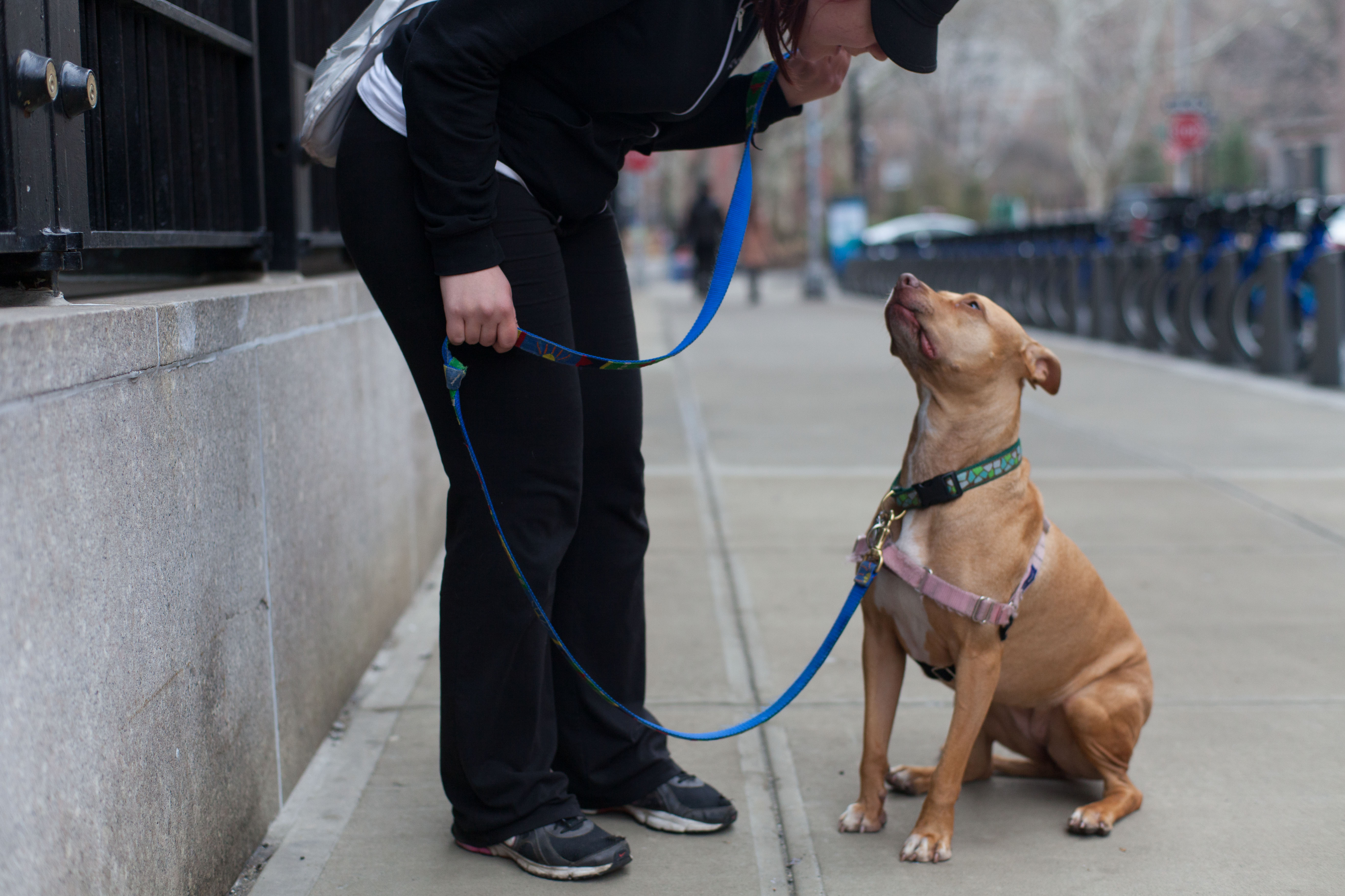
01 Sep Tips and Tricks For Dealing With a Pulling Dog
[mk_page_section]
I wasn’t afraid to ask for some help, and teamed up with Puptopia’s head trainer to learn some tips and tricks for dealing with a pulling dog!
As it turns out, we have been unintentionally teaching our dogs that pulling is okay. That may confuse you, since we have all clearly tried to discourage pulling. But the bottom line is that when a dog pulls, she wants something. And when we are getting yanked by her and she gets to where she wants to be or is able to grab that tennis ball she’s been eyeing: that’s a happy reward. Reward=good. Good=productive. We need to understand what a pup thinks of as a reward, and use that to patiently redirect our pup’s, and our behavior. Check it out!
[mk_circle_image src=”https://www.puptopianyc.com/wp-content/uploads/2016/05/IMG_20140422_122537.jpg” image_diameter=”500″]
How do we communicate with our pups? Consistency, of course. Teaching your pup to make eye contact with you is a great way to make sure they are always at the ready! We call this “checking in.” What teaching eye contact does is let your dog know she can ask for permission to act on what she wants, or that you approve of her actions. We can encourage eye contact by using higher grade treats (Make it exciting! Think real meat or walking faster)! When she looks at you, immediately give her a reward. This tells her, “Great job! You’re doing awesome!” As she gets better at this, she will start looking up at you more often. Slowly transition to rewarding her with all non-food rewards, like going to places she wants, walking faster, or even jogging a bit . Giving a dog exactly what she wants is a great way to reward – for more ideas, see our post on creative reward ideas!
Eventually, she will do this automatically. If she wants your permission, she’ll look up: “Can I? Can I?” And if she isn’t pulling…”Am I doing the right thing?” If yes, you can choose to reward.
A clicker (or an audible cue) can help pin-point good behavior when teamed with a reward. First, familiarize yourself with our posts on Timing, and Markers! You can use one to highlight when your pup does something great: like Checking In with you while walking! When your dog checks in, you click simultaneously (read the post on Timing)! For the marker to be effective, it needs to be given in tandem with the action.
What the Clicker specifically provides that a verbal cue may not is a consistent and clear mark. By highlighting a desired action with a click and reward, our dogs will associate that action with good things. That will help strengthen the good actions, and remind her to check in with you.
[mk_image src=”https://www.puptopianyc.com/wp-content/uploads/2016/08/IMG_0468-e1470510975671.jpg” image_width=”800″ image_height=”922″ crop=”true” lightbox=”false” frame_style=”simple” target=”_self” caption_location=”inside-image” align=”left” margin_bottom=”10″]
[mk_image src=”https://www.puptopianyc.com/wp-content/uploads/2016/07/KIMG2638.jpg” image_width=”800″ image_height=”1046″ crop=”true” lightbox=”false” frame_style=”simple” target=”_self” caption_location=”inside-image” align=”left” margin_bottom=”10″]
Another great tip for reminding your pup not to pull is to let her know that pulling isn’t going to get her anywhere faster. In fact, it may hinder her progress. If you find your pup is pulling and not checking in with you, simply stop walking. At first, your pup may try to keep going. You can tell her that’s not what you want by simply turning around and walking back. Be sure you don’t pull, yank, or yell at your dog. Those kind of physical and sudden actions can cause confusion, and scare our dogs. It’s best to keep calm, and gently walk the opposite direction. By doing this, you’re taking away what the reward of going to the desired object.
The point of this is to discourage unwanted behavior. You will know when your pup is figuring out that pulling is bad when she walks alongside you. When this happens, you have her attention again – reward it!
[mk_image src=”https://www.puptopianyc.com/wp-content/uploads/2016/07/IMG_20160712_145120.jpg” image_width=”800″ image_height=”1046″ crop=”true” lightbox=”false” frame_style=”simple” target=”_self” caption_location=”inside-image” align=”left” margin_bottom=”10″]
Let’s talk about the hardware we use to have a jaunty walk with our dogs. This can be a life line to making sure the walk is fun, calm and enjoyable for everyone involved when we can’t be actively training. We all love walks, but sometimes we just have someplace to go!
The number one rule when teaching a pup not to pull is to use a fixed length lead. That is, no retractable leashes! Retractable leads encourage pulling by rewarding a dog with more freedom each time they pull against the tension of the leash. Choose a sturdy, size appropriate leash that complies with your area’s leash laws (usually 6 feet maximum). Try out leather, nylon, rope -get a feel for what you like- after all, you’re going to be holding it!
Harnesses are a great way to protect your pup’s sensitive neck from the stress and strain of pulling. What should we look for in a harness? Make sure, of course, it’s the right size for your dog. A harness that is too tight can cause some hurt, and we don’t want that. A harness (or any gear) should be snug but not tight. But what we are also paying attention to is the function of the harness. You may have noticed that certain harnesses offer different hooks to connect your leash to. Sometimes, you will have a choice of clipping onto the back of your harness, or the front (against your dog’s chest).
These different clips provide different sensory cues to your pups when they pull. Clipping to the back of the harness engages a pup’s opposition reflex – meaning if you pull they’re just going to pull back. Because of this, using the back clip may not be the best option. It’s the front clip that offers more control when your dog pulls by turning your dog toward you when they pull.
[mk_circle_image src=”https://www.puptopianyc.com/wp-content/uploads/2016/08/IMG_1165.jpg” image_diameter=”500″]
The front clip, no-pull harness is a comfortable alternative to only using a collar, or the back clip harnesses which can sometimes put strain on our dogs (and us). Now, using a harness isn’t a cure-all for pulling. Teaming the harness with training is a good way to encourage your pup not to pull.
Head halters are a good choice for when you may have a little more difficulty physically handling your pup, due to size or strength differences. Some pups are STRONG and there’s no way you can just stop walking if they want to keep going!
We’re looking for many of the same things with halters as we are with harnesses. We want a secure fit – not too tight, but the neck piece should be snug and fit right up behind the ears. The muzzle piece should allow your dog to open her mouth, but not dangle loosely.
When using a halter it’s important to remember that you’re controlling your pup from a very sensitive area, her neck and face. Think gentle when using a halter – there’s no need to pull, yank, or correct. These actions can cause neck damage, and we want to avoid that!
Before we start training sessions with our pulling dog, we need to make sure the conditions are calm, relaxed, and prime for focus. Pick areas that are secluded from loud noises, busy traffic, or a lot of crazy distractions that could keep your pup’s focus off you. Start in a safe environment and exercise these tips and tricks for dealing with a pulling dog. As we see progress, we can add more elements that could excite or distract our pups.
Proper dog training depends on clear, attentive communication between dog and human. Pay attention to how you deliver your cues, and how your pup responds. There’s nothing wrong with making small adjustments that communicate clearly and effectively. While working with the dog that pulled, I implemented these tips into our daily walks. With patience, I started to notice gradual progress. Soon, we were walking in tedmen together, instead of me trailing behind. So, keep calm and persistent, and have fun working with your dog!




No Comments